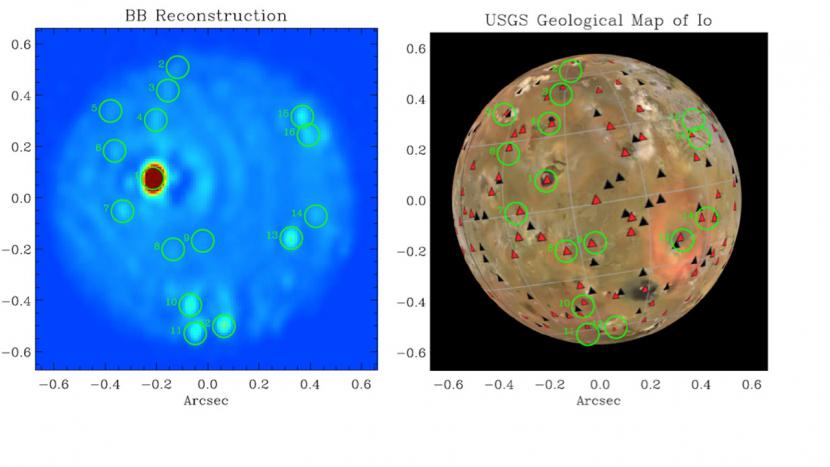News
Giant Telescope Takes a Close Look at a Lava Lake on Jupiter’s Moon Io
 Io seen by LBT (left) on 2013 December 24 (left) compared to a USGS map (right) based on images from NASA’s Voyager 1 and 2 missions (acquired in 1979) as well as the Galileo orbiter (1995-2003). Loki Patera is the bright red spot on the LBT image. Credit: LBTO-USGS
Io seen by LBT (left) on 2013 December 24 (left) compared to a USGS map (right) based on images from NASA’s Voyager 1 and 2 missions (acquired in 1979) as well as the Galileo orbiter (1995-2003). Loki Patera is the bright red spot on the LBT image. Credit: LBTO-USGS Scientists recently confirmed information regarding Loki Patera, a volcanic depression on Io (the innermost of Jupiter's four moons) that, up until recently, scientists were unable to closely examine. Using the combined Large Binocular Telescope (LBT) and Large Binocular Telescope Interferometer (LBTI), in addition to the LMIRcam, the camera recording images in the LBTI, scientists found evidence that suggests Loki Patera's bright emissions are actually an active overturning lava lake, a finding that points to confirmations of past hypotheses.
From the press release provided by Large Binocular Telescope Observatory: "While we have seen bright emissions – always one unresolved spot – “pop-up” at different locations in Loki Patera over the years”, explains Imke de Pater, a Professor at the University of California in Berkeley, "these exquisite images from the LBTI show for the first time in groundbased images that emissions arise simultaneously from different sites in Loki Patera. This strongly suggests that the horseshoe-shaped feature is most likely an active overturning lava lake, as hypothesized in the past.”
"Two of the volcanic features are at newly-active locations", explains Katherine de Kleer, a graduate student at the University of California at Berkeley. "They are located in a region called the Colchis Regio, where an enormous eruption took place just a few months earlier, and may represent the aftermath of that eruption. The high resolution of the LBTI allows us to resolve the residual activity in this region into specific active sites, which could be lava flows or nearby eruptions."
